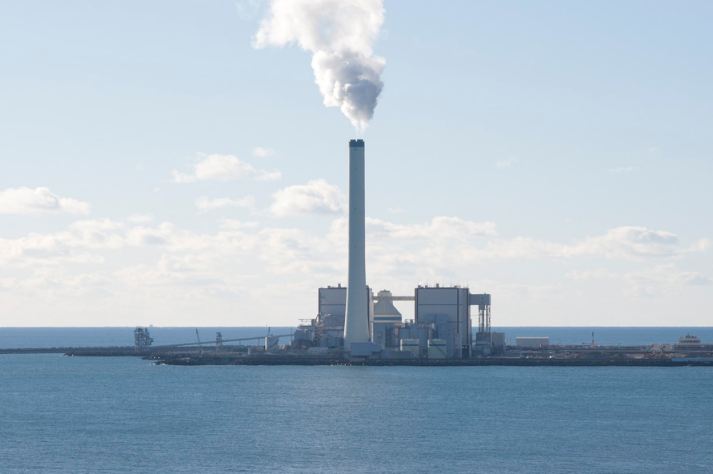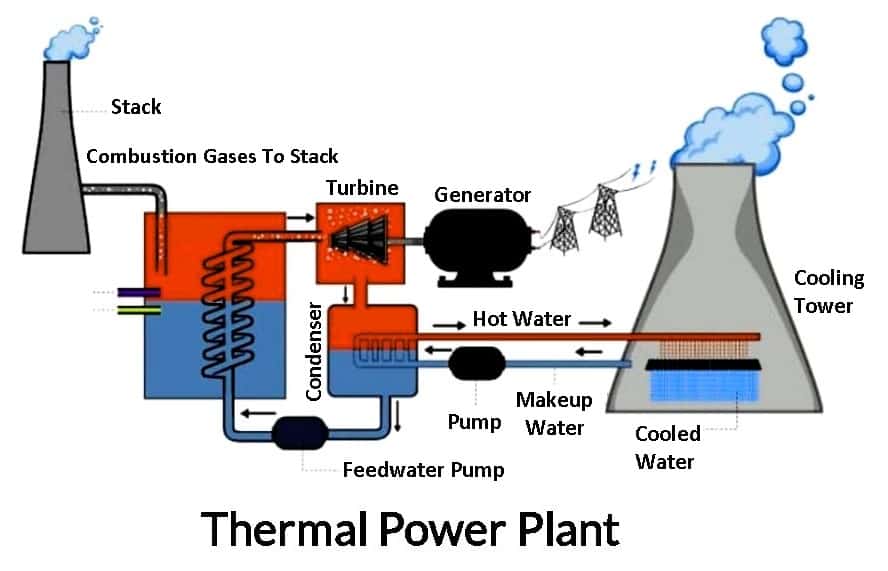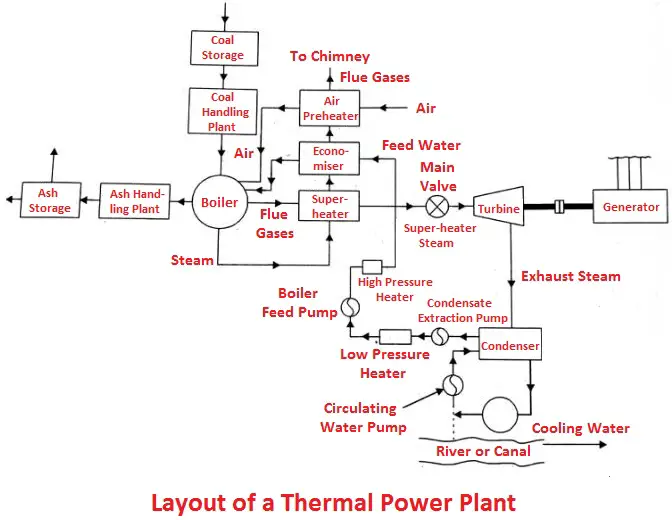Season and daytime have a big impact on electricity demand. The thermal power plant is essential to maintaining the supply of electricity because it can adapt quickly to changes in demand.
A thermal power plant, also known as a thermal power station, is used to transform heat energy into electric power for domestic and industrial applications. Electric power is generated by steam-powered turbines, which convert heat to mechanical power.
So let’s understand the basics of a thermal power plant.
You might like: What Are The Different Types of Power Plants?
Introduction to Thermal Power Plant
The Role of Thermal Power Plant in the Modern Power Generation Scenario.
The development of thermal power plant in any country depends upon the available resources in that country. The hydro-power plant totally depends on the natural availability of the site and the hydrological cycle. The new sites cannot be created manually for hydropower plants.

The development of nuclear power requires high investment and technology. In many tinies, the hydro-power plant suffers if a drought comes even once during a decade and the complete progress of the nation stops. The calamity of rain drought on the power industry has been experienced in many states in the country.
To overcome this difficulty, it is necessary to develop thermal power plants in the country which are very suitable for baseload plants. The coal resources in India account for about 5.7% of the proven reserves in the world.
The geological reserves of coal in India are 193.8 billion tonnes. The thermal power sector contributes nearly about 66% of installed capacity in India.
The coal production in the country is increasing at the rate of 4.6% every year and new plants are set up in many parts of the country to increase the power production to meet the demand to increase the per capita income of the country.
Due to increased power generation –
- The country’s income can be increased.
- The standard of living can be increased.
- Reducing the unemployment
- Development in all sectors.
- Development in new technology.
- The GDP of the country can be increased.
Read also: What is Power Plant Economics? How To Calculate It?
Components of Thermal Power Plant
A thermal power plant generates electricity. In addition to generating electricity, certain thermal power plants are designed to generate heat for industrial purposes, such as district heating or water desalination.
The following are the components and operating principles of a thermal power plant.
- River or Canal
- Heater
- Boiler
- Superheater
- Economizer
- Alternator
- Condenser
- Cooling tower and ponds
- Air pre-heater
- Turbine
- Feedwater pump
Here are the main components and functions of a thermal power plant with a diagram.

#1 River or Canal
It is well known here that a large amount of water is required, and this water is also used to generate electricity through the process of electrolysis.
#2 Heater
Depending on the name according to which it is used, low-pressure heaters or high-pressure heaters increase or decrease the pressure of water.
#3 Boiler
There are two sections in the boiler: one for coal storage and handling, which stores the coal and then uses it as needed. The ash handling and storage plant is the other section, where the coal burning process’s produced ash is sent for ash storage.
The pulverized coal and air mixture is added to the boiler, which is burned in the combustion area. When the fuel is ignited, a sizable fireball forms in the center of the boiler, radiating a significant amount of heat energy.
At high temperatures and pressures, the heat energy is used to turn the water into steam. The boiler walls are covered with steel tubes where steam is produced from water. After passing through the superheater, economizer, and air preheater, the flue gases from the boiler are finally exhausted into the atmosphere through the chimney.
#4 Superheater
This superheater tube is located at the very end of the boiler where the water is the hottest. In the superheater, the saturated steam generated in the boiler tubes is heated to a maximum temperature of 540 °C. The superheated high-pressure steam is then fed into the steam turbine.
#5 Economizer
A boiler’s feedwater is heated by an economizer before being supplied to the boiler. When the water pressure is raised, some heat is generated and sent from the economizer to the boiler.
#6 Alternator
An alternator is connected to the steam turbine. Electricity is produced when the turbine turns the alternator. A transformer is then used to increase the electrical voltage that is generated before transmitting it to the intended location.
#7 Condenser
The condenser is used to cool the working fluid or, more precisely, to remove heat from the water. The condenser uses cold water circulation to condense the exhaust steam. Here, the steam cools down and turns back into water after losing both pressure and temperature.
Condensing is necessary because compressing a fluid in a gaseous state requires a significant amount more energy than compressing a liquid. The cycle becomes more effective as a result of condensing.
#8 Cooling Tower and Ponds
To condense the steam, a condenser needs an adequate quantity of water. Most plants employ a cooled cooling system, which involves cooling and reusing warm condenser water. A cooling tower is a 150m-tall hyperbolic structure made of steel or concrete.
#9 Air Pre-Heater
Air from the atmosphere is drawn in by the main fan and heated in the air pre-heater. In the boiler, pre-heated air is mixed with coal. Preheating the air has the benefit of enhancing coal combustion.
#10 Turbine
The turbine’s primary purpose is to turn the blades when steam passes through it, converting the heat energy into mechanical energy. Turbine blades rotate as a result of high-pressure, superheated steam being fed into the steam turbine.
The steam turbine, which serves as the prime mover, transforms the energy in the steam into mechanical energy. As the steam travels through the turbine, its pressure and temperature are reduced and its volume is increased. The condenser exhausts the expanded low-pressure steam.
#11 Feedwater Pump
A feedwater pump once more supplies the condensed water to the boiler. During the cycle, some water could be lost, but it is still adequately supplied by an outside water source.
You might like: Different Types of Wind Turbine: Their Working & Applications
The layout of the Modern Thermal Power Plant
The general layout of the thermal power plant is shown in the figure and it consists of the following four circuits:
- Coal and ash circuit
- Ash and gas circuit
- Feedwater and steam flow circuit
- Cooling water circuit.

Working of Thermal Power Plant
Coal received in the coal storage yard of the power station is transferred to the furnace by the coal handling unit. The heat generated due to the burning of coal is used in converting water included in the boiler drum into steam at suitable pressure and temperature.
The steam generated is passed through the superheater. Superheated steam then flows through the turbine. The pressure decreases after some work is done in the turbine. Steam after leaving the turbine pass through the condenser which maintains the low pressure at the exhaust of the turbine.
The pressure of the steam in the condenser depends on the flow rate and temperature of the cooling water flow, and on the effectiveness of the air removal equipment. Water circulating through the condenser may be taken from various sources such as rivers, lakes, or the sea.
If insufficient water is not available, the hot water coming out of the condenser can be cooled in cooling towers and circulated through the condenser again. Bled steam from the turbine at extraction points is sent to low-pressure and high-pressure water heaters.
The air taken from the environment is first passed through the air preheater, where it is heated by exhaust gases. The hot air then passes through the furnace. The exhaust gases flow through the dust collector and then through the economizer, and air pre-heater, and finally, they are exhausted into the atmosphere through the chimney.
You might like: 10 Different Types of Air Conditioners and Their Applications
Factors for Selection of Site for Thermal Power Plant
The following factors are to be considered for the selection of the site:
#1 Availability of Coal
The coal should be available in sufficient quantity nearer to the plant at a low cost.
#2 Ash Disposal Facilities
There must be sufficient space to dispose of a large quantity of ash.
#3 Space Requirement
Sufficient land should be available for the construction of the plant at a low cost with future expansion scope.
#4 Nature of land
The site for the plant should have good bearing capacity to withstand the dead load of the plant.
#5 Availability of water
A large quantity of water should be available for drinking, condensing, disposal of ash, and as feedwater at a low cost throughout the year nearer to the site.
#6 Transportation facilities
The site should be connected by suitable transportation lines such as road and rail to bring the machinery, coal, etc.
#7 Availability of labor
A cheap and large number of laborers should be available at the proposed site as a large number of laborers are required during the construction of the plant.
#8 Public problem
The site should be away from the towns to avoid the nuisance of smoke, fly ash, etc.
#9 Nearness to the load centre
The site should be nearer to the load center to reduce transmission costs and losses.
- The initial cost of the plant
- The nature and magnitude of the load to be handled.
- The necessity of future expansion of the plant.
You might like: Different Types of Furnaces and Their Working
Materials Required for Thermal Power Plant
The following basic materials are essentially required by the thermal power plant:
- Feedwater
- Coal
- Cooling water.
- Water for ash disposal.
- SO2
- Air
1. Feedwater
The feed water is the water circulated through a closed circuit of the power plant which is further converted into steam in the boiler. For example, a plant of 100 MW capacity may require nearly 500 tons of water per hour to be circulated through the system
2. Coal
The coal is required for converting the feed water into the steam in the boiler. A sufficient quantity of coal is required. So that the plant should run without any stoppage due to the coal shortage. Nearly 1500 tons/day coal is required for 100 MW capacity plant generating 5 kg/kWh of steam.
3. Cooling water
The cooling water is required for condensing the steam coming out from the turbines. Nearly 25000 tons/hr quantity of water is required for a 100 MW plant.
4. Water for ash disposal
A large quantity of water is required for disposing of the ash. Nearly 5 kg of water is required per kg of ash disposal.
5. SO2 (Low Sulfur contains coal)
We should always be required to have low sulfur content coal because on burning such coal generates SO2 and it is highly poisonous to human and animal health and as well as for the crops. Nearly 1.8 tons/hr amount of SO2 is coming out by burning the coal containing sulfur up to 1 to 1.5% in 100 MW capacity plant. This SO2 should be properly removed from the exhaust gases through improved technology.
6. Air
Air is required for the combustion of the fuel as well as required for cooling the water in the cooling tower. Nearly 1200 tons of air per hour for a 100 MW capacity plant, in addition to this nearly 25000 tons of air per hour is to be required for circulating in the cooling tower.
You might like: What are the Types of Solar Cells?
Types of Fuels Utilized in Thermal Power Plant
Following are the types of fuels utilized in thermal power plants:
- Natural gas
- Coal
- Oil
- Geothermal energy
- Nuclear fuel
- Waste heat from industrial process
- Biomass – These plants are fuelled by waste from sugarcane, landfill methane and municipal waste, etc.
- Solar heat
- Blast furnace gas.
Advantages of Thermal Power Plants
The following are the advantages of thermal power plants:
- The fuel cost of the thermal power plant is relatively low.
- Thermal energy can be produced everywhere in the world.
- The heat production system is simple compared to other systems.
- The overall system is cost-effective.
- Easy mechanism.
- The same heat could be reused.
- Easier maintenance of the power station.
- The use of water is prominent here, therefore any place with ample water is a perfect location for installing a thermal power plant.
- These plants require comparatively small space to be installed.
- Its construction cost is cheaper due to the nearness of urban areas.
- These plants are completed within a few years.
- They are generally located near the urban areas.
- The scope of expansion is unlimited.
- These are located in a place where the displacement of people is minimum.
- They can be located near the consumption centers.
- The cost-benefit ratio is always better than the hydel power plant.
Disadvantages of Thermal Power Plant
The following are the disadvantages of thermal power plants:
- The raw materials used are exhaustible resources,
- The ability of these plants depends on the quality of the coal.
- High maintenance cost.
- High production of CO2 in the atmosphere.
- Exhaust gases harm the environment badly.
- Low overall efficiency.
- Thermal engines require a huge amount of lubricating oil that is very expensive.
- Nuclear thermal power plant demands an excessive amount of water for cooling purpose.
- Coal-type thermal power plant requires a larger duration before it supplies the generated power to the grid.
- This type of power station is ultimately responsible for the rise in seawater levels.
- Shorter life span.
- It is very difficult to maintain the optimum supply for a long period.
Read Next: Hydro Power Plant: Types, Working, Advantages, and Disadvantages
Conclusion
That’s it. Thanks for reading. I hope I have covered everything about the “Thermal Power Plant Diagram” It would be helpful if you could let me know if there was anything I missed or if you have any doubts about anything I wrote.
Please share this article with your friends if you find it interesting.
Want free PDFs direct to your inbox? Then subscribe to our newsletter.
Download PDF of this article:
You might like to read more in our blog:
- What is Solar Power Plant? Its Working and Types
- Types of Heat Exchangers & Their Application
- Types of Refrigeration: Their Advantages & Disadvantages
External Links:
I really value your hard-working work in bringing this helpful article. Thank you for sharing this helpful data.
Thanks for your feedback.
Thermal power plant article is very useful, it can used to educate young engineers in the engineering industries.
I’m glad it was helpful for you. Keep visiting 😉